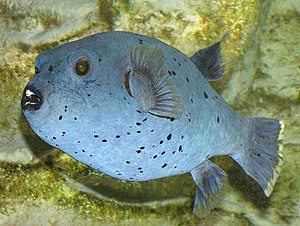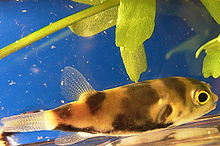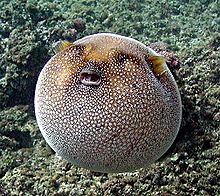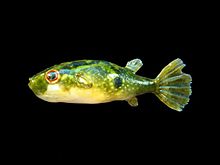Puffer fish
| Puffer fish | ||||||||||||
|---|---|---|---|---|---|---|---|---|---|---|---|---|

Black-spotted pufferfish ( Arothron nigropunctatus ) |
||||||||||||
| Systematics | ||||||||||||
|
||||||||||||
| Scientific name | ||||||||||||
| Tetraodontidae | ||||||||||||
| Bonaparte , 1832 |
The family of the puffer fish (Tetraodontidae (= four-toothed )) belongs to the subordination of the puffer fish-like (Tetraodontoidei) in the order puffer fish relatives (Tetraodontiformes). The puffer fish include around 200 species. Their body length varies between 2 centimeters in the dwarf or pea puffer fish ( Carinotetraodon travancoricus ) and 120 centimeters in the giant puffer fish ( Arothron stellatus ).
Appearance
The body shape of puffer fish differs greatly from the typical fish shape. He has a rounded, compact shape. The head and eyes are well developed. The beak-like bite apparatus consists of teeth that have grown together to form tooth strips, with two tooth strips at the top and two at the bottom. The scientific naming of this family of highly developed bony fish also relates to this: Tetraodontidae = four-toothed fish . Their leathery, resilient skin is bare, the scales are reduced to short spines.
It is driven mainly by the pectoral fins . The dorsal fin and anal fin are only buzzing along for support. The tail stalk and tail fin serve as the rudder. As a result, the puffer fish is quite slow, but extremely agile. He can swim both forwards and backwards and climb up and down. A peculiarity of the puffer fish is that they have no ventral fins.
In case of danger, puffer fish can inflate themselves because strong muscles jerkily press water from the oral cavity into a belly-side, sac-like enlargement of the stomach. This should act as a deterrent to attackers. Strong circular muscles at the stomach entrance prevent the water from flowing back. The spines, which are otherwise close to the body, now stand outwards and act as barbs. Because of this and the enormous increase in volume, it is almost impossible for a predator to devour the puffer fish. Jacques Cousteau reports that puffer fish in the throats of large predatory fish (sharks) inflate themselves so that they get stuck and the predator suffocates. If puffer fish are deliberately provoked to inflate by humans, this is associated with great stress for the fish - it is difficult for them to expel the water they have absorbed. Outside the water, they pump air into the stomach sac, but soon suffocate.
distribution
Puffer fish occur worldwide in a belt of approx. 47 degrees north to 47 degrees south latitude in the coastal regions of tropical and warm seas, mostly over coral banks or seagrass beds. Some species live in the Amazon , in tropical Africa, in eastern India and in Southeast Asia also in fresh and brackish water .
Behavior towards people
Puffer fish tend to be shy and generally avoid divers and snorkelers. If a person tries to catch the fish, it will bite with his strong teeth. In large puffer fish, this can lead to serious injury or even loss of a finger.
Toxicity
The entrails of many puffer fish are poisonous. The main component of the poison of the puffer fish is tetrodotoxin (TTX), which is found especially in the skin , liver and, in many species, in the ovaries of the fish during spawning , but not in muscle meat . Tetrodotoxin owes its name to the puffer fish family (Tetraodontidae) and was first isolated from the ovaries of a puffer fish in 1950 .
This neurotoxin is one of the strongest known non -proteinaceous poisons: the lethal dose is only about 10 µg / kg body weight. It only affects the body's nerves, not the brain - victims become completely paralyzed and unable to move or speak, but remain conscious. They then die from paralysis-related respiratory failure or from cardiac arrest. If breathing and circulation are kept going fast enough by emergency measures, the toxic effects will subside within about 24 hours and the victims will not suffer any permanent damage.
It is believed that the various types of puffer fish do not synthesize the neurotoxin themselves. Bacteria that the fish presumably ingests through food (e.g. various crustaceans, worms and red algae) are held responsible for this. For example, Pseudomonas bacteria in the species Takifugu poecilonotus and various Vibrionen , z. B. the bacterium Vibrio alginolyticus found in Takifugu vermicularis . These bacteria are considered to be TTX producers. However, the thesis that bacteria cause the poison formation was again questioned.
In order to avoid the risk of poisoning when eating fugu , the species Takifugu rubripes , among others, is bred in captivity. A special feed is used and care is taken that the fish do not ingest any TTX-containing organisms. The grown fugu are therefore actually non-toxic. This is taken as evidence that the fish does not produce tetrodotoxin by itself.
Protection through the formation of tetrodotoxin is widespread in the animal kingdom. For example, this protective mechanism can also be found in the blue-ringed octopus and various amphibians such as the rough-skinned yellow-bellied newt . The species Takifugu vermicularis is an important model organism for research into tetrodotoxin formation in the animal kingdom. Some other species of pufferfish poisonous by tetrodotoxin are Canthigaster valentini , Lagocephalus lagocephalus , Chelonodon patoca and Tetraodon lineatus .
Genera and species
|
Internal systematics according to Yamanoue et al.
|





There are over 25 genera with around 200 species. The division into the subfamilies round-headed and pointed puffer fish is not made here, since the round-headed puffer fish are not a monophylum .
- Genus Amblyrhynchotes Troschel, 1856
- Amblyrhynchotes honckenii (Bloch, 1785)
- Genus Arothron Müller , 1841
- Blue-spotted pufferfish ( Arothron caeruleopunctatus ) Matsuura, 1994
- Arothron carduus ( Cantor , 1849)
- Masked puffer ( Arothron diadematus ) ( Rüppell , 1829)
- Arothron firmamentum ( Temminck & Schlegel , 1850)
- Arothron gillbanksii (Clarke, 1897)
- White-spot pufferfish ( Arothron hispidus ) ( Linnaeus , 1758)
- Immaculate pufferfish ( Arothron immaculatus ) ( Bloch & Schneider , 1801)
- Arothron inconditus Smith, 1958
- Arothron leopardus (Day, 1878)
- Map puffer ( Arothron mappa ) ( Lesson , 1831)
- Manila puffer ( Arothron manilensis ) (de Procé, 1822)
- Guinea fowl puffer ( Arothron meleagris ) ( Lacépède , 1798)
- Arothron multilineatus Matsuura, 2016
- Black-point pufferfish ( Arothron nigropunctatus ) (Bloch & Schneider, 1801)
- Arothron reticularis (Bloch & Schneider, 1801)
- Giant pufferfish ( Arothron stellatus ) (Bloch & Schneider, 1801)
- Genus Auriglobus Kottelat, 1999
- Auriglobus amabilis (Roberts, 1982)
- Auriglobus modestus (Bleeker, 1851)
- Auriglobus nefastus (Roberts, 1982)
- Auriglobus remotus (Roberts, 1982)
- Genus pointed puffer fish ( Canthigaster )
- Genus Carinotetraodon Benl, 1957
- Carinotetraodon borneensis (Regan, 1903)
- Carinotetraodon imitator Britz & Kottelat, 1999
- Carinotetraodon irrubesco Tan, 1999
- Comb puffer ( Carinotetraodon lorteti ) (Tirant, 1885)
- Carinotetraodon salivator Lim & Kottelat, 1995
- Dwarf puffer ( Carinotetraodon travancoricus ) (Hora & Nair, 1941)
- Genus Chelonodontops Smith, 1958
- Chelonodontops alvheimi Psomadakis et al., 2018
- Chelonodontops bengalensis Psomadakis et al., 2018
- Chelonodontops laticeps (Smith, 1948)
- Milk stains pufferfish ( Chelonodontops patoca ) (Hamilton, 1822)
- Chelonodontops pleurospilus (Regan, 1919)
- Chelonodontops leopardus (Day 1878)
- Genus Chonerhinos Bleeker, 1854
- Chonerhinos naritus (Richardson, 1848)
- Chonerhinos silus Roberts, 1982
-
Colomesus Gill, 1884
- Woodlouse puffer ( Colomesus asellus ) ( Müller & Troschel, 1849)
- Parrot puffer ( Colomesus psittacus ) (Bloch & Schneider, 1801)
- Colomesus tocantinensis Amaral, Brito, Silva, Carvalho, 2013
- Genus Contusus Whitley, 1947
- Contusus brevicaudus Hardy, 1981
- Contusus richei (Fréminville, 1813)
- Genus Dichotomyctere Duméril, 1855
- Dichotomyctere erythrotaenia (Bleeker, 1853)
- Dichotomyctere fluviatilis (Hamilton, 1822)
- Dichotomyctere kretamensis (Inger, 1953)
- Green puffer fish ( Dichotomyctere nigroviridis ) (Marion de Procé, 1822)
- Palembang puffer ( Dichotomyctere ocellatus ) (Steindachner, 1870)
- Dichotomyctere sabahensis Dekkers, 1975
- Genus Ephippion Bibron in Duméril, 1855
- Genus Feroxodon Su, Hardy & Tyler, 1986
- Genus Guentheridia Gilbert & Starks, 1904
- Guentheridia formosa (Günther, 1870)
- Genus Javichthys Hardy, 1985
- Genus Lagocephalus Swainson, 1839
- Lagocephalus gloveri Abe & Tabeta, 1983
- Lagocephalus guentheri Miranda-Ribeiro, 1915
- Lagocephalus inermis (Temminck & Schlegel, 1850)
- Lagocephalus laevigatus ( Linnaeus , 1766)
- Lagocephalus lagocephalus ( Linnaeus , 1758)
- Lagocephalus lunaris (Bloch & Schneider, 1801)
- Lagocephalus sceleratus ( Gmelin , 1789)
- Lagocephalus spadiceus (Richardson, 1845)
- Lagocephalus suezensis Clark & Gohar, 1953
- Lagocephalus wheeleri Abe, Tabeta & Kitahama, 1984
- Genus Leiodon Swainson, 1839
- Leiodon cutcutia (Hamilton, 1822)
- Genus Marilyna Hardy, 1982
- Genus Omegophora Whitley, 1934
- Genus Pao Kottelat, 2013
- Genus Pelagocephalus Tyler & Paxton, 1979
- Genus Polyspina Hardy, 1983
- Genus Reicheltia Hardy, 1982
- Genus Sphoeroides Lacépède, 1798
- Sphoeroides andersonianus Morrow, 1957
- Sphoeroides angusticeps (Jenyns, 1842)
- Ring puffer ( Sphoeroides annulatus ) (Jenyns, 1842)
- Sphoeroides cheesemanii (Clarke, 1897)
- Sphoeroides dorsalis Longley, 1934
- Sphoeroides georgemilleri Shipp, 1972
- Sphoeroides greeleyi (Gilbert, 1900)
- Sphoeroides kendalli Meek & Hildebrand, 1928
- Sphoeroides lispus Walker, 1996
- Lobed puffer fish ( Sphoeroides lobatus ) ( Steindachner , 1870)
- Sphoeroides maculatus (Bloch & Schneider, 1801)
- Marble puffer ( Sphoeroides marmoratus ) (Lowe, 1838)
- Sphoeroides nephelus ( Goode & Bean , 1882)
- Sphoeroides nitidus Griffin, 1921
- Sphoeroides pachygaster ( Müller & Troschel, 1848)
- Sphoeroides parvus Shipp & Yerger, 1969
- Sphoeroides rosenblatti Bussing, 1996
- Sphoeroides Sechurae Hildebrand, 1946
- Sphoeroides spengleri ( Bloch , 1785)
- Sphoeroides testudineus ( Linnaeus , 1758)
- Sphoeroides trichocephalus ( Cope , 1870)
- Sphoeroides tyleri Shipp, 1972
- Sphoeroides yergeri Shipp, 1972
- Genus Takifugu Abe, 1949
- Takifugu alboplumbeus (Richardson, 1845)
- Takifugu basilevskianus (Basilewsky, 1855)
- Takifugu bimaculatus (Richardson, 1845)
- Takifugu chinensis (Abe, 1949)
- Takifugu chrysops (Hilgendorf, 1879)
- Takifugu coronoidus Ni & Li, 1992
- Takifugu exascurus (Jordan & Snyder, 1901)
- Takifugu flavidus (Li, Wang & Wang in Cheng et al., 1975)
- Takifugu flavipterus Matsuura, 2017
- Takifugu niphobles (Jordan & Snyder, 1901)
- Takifugu oblongus (Bloch, 1786)
- Takifugu obscurus (Abe, 1949)
- Takifugu ocellatus (Linnaeus, 1758)
- Takifugu orbimaculatus Kuang, Li & Liang, 1984
- Takifugu pardalis (Temminck & Schlegel, 1850)
- Takifugu poecilonotus (Temminck & Schlegel, 1850)
- Takifugu porphyreus (Temminck & Schlegel, 1850)
- Takifugu pseudommus (Chu, 1935)
- Takifugu radiatus (Abe, 1947)
- Takifugu reticularis (Tien, Cheng & Wang in Cheng et al., 1975)
- Takifugu rubripes (Temminck & Schlegel, 1850)
- Takifugu snyderi (Abe, 1988)
- Takifugu stictonotus (Temminck & Schlegel, 1850)
- Takifugu vermicularis (Temminck & Schlegel, 1850)
- Takifugu xanthopterus (Temminck & Schlegel, 1850)
- Genus Tetractenos Hardy, 1983
- Genus Tetraodon Linnaeus, 1758
- Tetraodon barbatus Roberts, 1998
- Tetraodon duboisi (Poll, 1959)
- Tetraodon implutus (Jenyns, 1842)
- Tetraodon lineatus (Linnaeus, 1758)
- Mbu pufferfish ( Tetraodon MBU ) (Boulenger, 1899)
- Brown puffer ( Tetraodon miurus ) (Boulenger, 1902)
- Tetraodon pustulatus Murray, 1857
- Congo puffer ( Tetraodon schoutedeni ) Pellegrin, 1926
- Tetraodon waandersii Bleeker, 1853
- Genus Torquigener Whitley, 1930
- Genus Tylerius Hardy, 1984
use
Aquarium keeping

Some puffer fish can be kept as aquarium fish in fresh , brackish or saltwater aquariums. In freshwater aquariums they can be used for biological control of snails . The dwarf puffer fish ( Carinotetraodon travancoricus ) and the woodlice puffer fish ( Chelichthys asellus ) are considered to be relatively unproblematic . B. in the scramble for food, snap at the fins of other fish. In the saltwater aquarium you can sometimes see species of the genus Canthigaster or Arothron . In general, puffer fish are not easy to socialize in the aquarium and are therefore often kept in a species aquarium or in individual keeping.
Use as edible fish
In Japan, despite their poison, puffer fish are eaten as a specialty ( fugu ) after special preparation , which consists in particular of the muscle meat of puffer fish.
Research object in genetics
The species Takifugu rubripes is used as a research object in some biological laboratories. The sequencing of its genome has been completed of 2002. It has a size of 365 megabases , making it the smallest known genome of a vertebrate .
Others
The free operating system OpenBSD uses a stylized puffer fish named Puffy as its logo or mascot .
supporting documents
literature
- Kurt Fiedler: Textbook of Special Zoology, Volume II, Part 2: Fish , Gustav Fischer Verlag, Jena, 1991, ISBN 3-334-00339-6 .
- Joseph S. Nelson : Fishes of the World , John Wiley & Sons, 2006, ISBN 0-471-25031-7 .
- Rudie H. Kuiter / Helmut Debelius : Atlas der Meeresfische , Kosmos-Verlag, 2006, ISBN 3-440-09562-2 .
- Hans A. Baensch / Robert A. Patzner: Mergus Sea Water Atlas Volume 6 Non-Perciformes (Non-Perciformes) , Mergus-Verlag, Melle, 1999, ISBN 3-88244-116-X .
- Kyosuke Tsuda: About Tetrodotoxin, Toxic Substance of Blowfish - Natural Sciences 53 (7), pp. 171-176 (January, 1966). ISSN 0028-1042
- Dieter Eichler: Recognizing dangerous marine animals , blv, 2005, ISBN 3-405-16992-5 .
Web links
- Puffer fish on Fishbase.org (English)
- Website for the identification, keeping and breeding of puffer fish
- Freshwater and brackish puffer fish in the aquarium guide
- Additional information on puffer fish
Individual evidence
- ^ A b Joseph S. Nelson, Terry C. Grande, Mark VH Wilson: Fishes of the World. Wiley, Hoboken, New Jersey, 2016, ISBN 978-1118342336 , page 525
- ↑ Yotsu, M., T. Tamazaki, Y. Meguro, A. Endo, M. Murata, H. Naoki, and T. Yasumoto: Production of tetrodotoxin and its derivatives by Pseudomonas sp. isolated from the skin of a pufferfish. In: Toxicon 25 (1987): 225-228. PMID 3576639
- ↑ T. Noguchi, DF Hwang, O. Arakawa, H. Sugita, Y. Deguchi, Y. Shida and K. Hashimoto: Vibrio alginolyticus , a tetrodotoxin-producing bacterium, in the intestines of the fish Fugu vermicularis vermicularis. In: Marine Biology 955 : 625-630 (1987). doi: 10.1007 / BF00431409
- ↑ Kim, DS, Kim, CH: No ability to produce tetrodotoxin in bacteria - authors reply. In: Applied and Environmental Microbiology , May 2001, p. 2393-2394 AEM Online
- ↑ Tamao Noguchi, Osamu Arakawa, Tomohiro Takatani: Toxicity of pufferfish Takifugu rubripes cultured in netcages at sea or aquaria on land. In: Comparative Biochemistry and Physiology Part D: Genomics and Proteomics Volume 1, Issue 1, March 2006, Pages 153–157, doi: 10.1016 / j.cbd.2005.11.003 .
- ↑ Yusuke Yamanoue, Masaki Miya, Hiroyuki Doi, Kohji Mabuchi, Harumi Sakai, Mutsumi Nishida: Multiple Invasions into Freshwater by Pufferfishes (Teleostei: Tetraodontidae): A Mitogenomic Perspective. PLoS ONE 6 (2): e17410. doi: 10.1371 / journal.pone.0017410
- ↑ Dichotomyctere on Fishbase.org (English)
- ↑ Maurice Kottelat : The fishes of the inland waters of Southeast Asia: A catalog and core bibliography of the fishes known to occur in freshwaters, mangroves and estuaries. The Raffles Bulletin of Zoology, November 2013, Supplement No. 27, PDF .
- ↑ Das Fugu-Genom-Projekt (English) ( Memento of the original from October 26, 2001 in the Internet Archive ) Info: The archive link was inserted automatically and has not yet been checked. Please check the original and archive link according to the instructions and then remove this notice.










